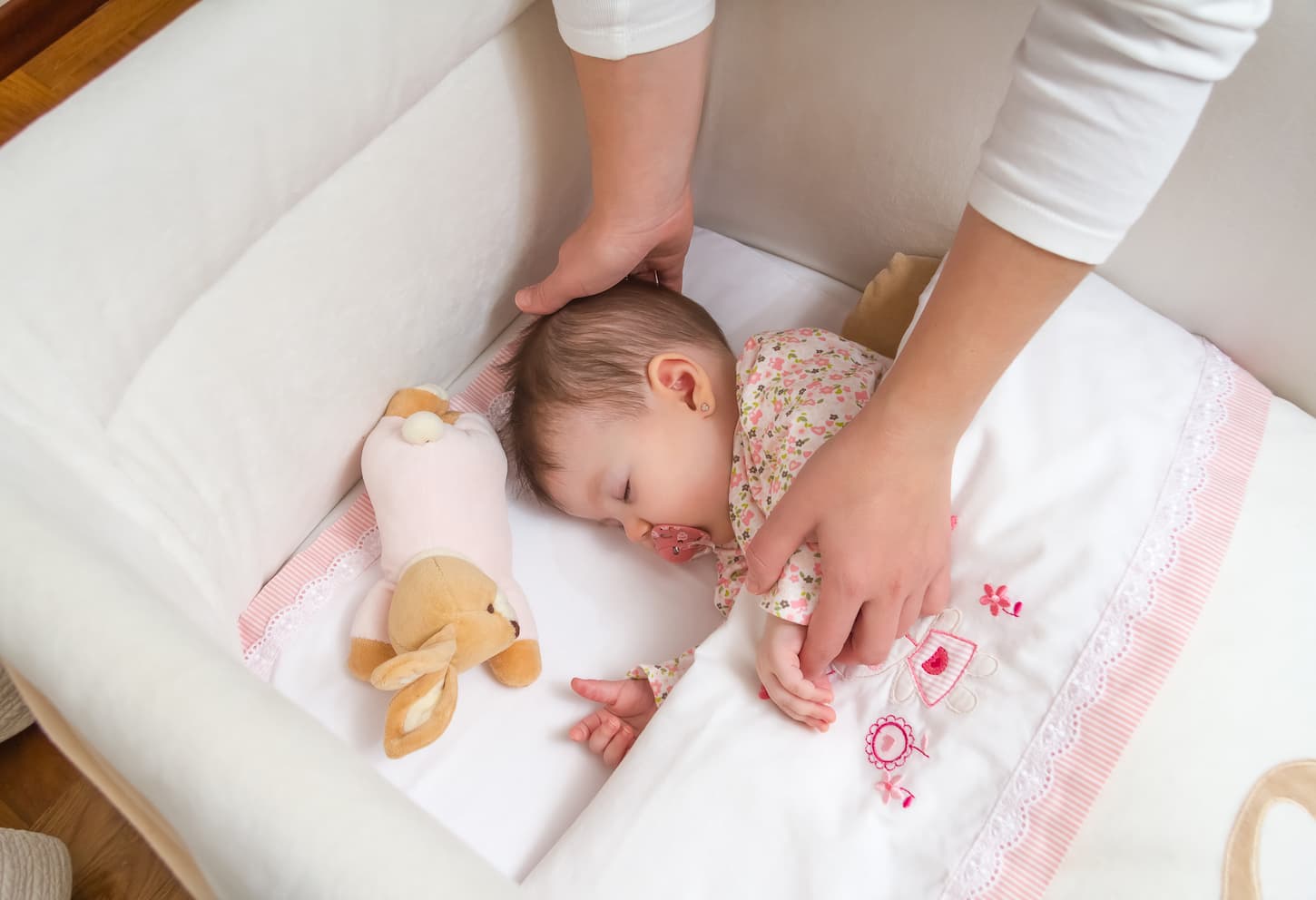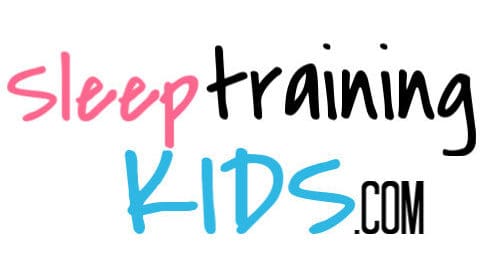A commonly asked question about sleep training is this: is it safe and okay to sleep train? Or is it cruel, risky, traumatizing, and just plain bad?
In other words, is sleep training safe or not? Sleep training, when done correctly, is completely safe and is a great short-term tool to help families get better sleep with no long-term effects. Done incorrectly, however, it can be risky, cruel, traumatizing, and even dangerous.
That being said, let’s look at the when and how of both sides – how sleep training could be risky and the ways in which it can be done safely.

Safe or Cruel? Sleep Training at a Glance
Here’s what long-term sleep training studies have to show regarding the safety and efficacy of sleep training:
Behavioral sleep techniques have no marked long-lasting effects (positive or negative.) Parents and health professionals can confidently use these techniques to reduce the short- to medium-term burden of infant sleep problems and maternal depression.
American Academy of Pediatrics, October 2012 Volume 130 Issue 4
In other words, scientists measured both the effect and stress hormone (cortisol) levels in babies to determine its efficacy and levels of safety.
Here’s another sleep training study result:
…the babies in the sleep training groups showed slightly lower cortisol levels than the babies who had no sleep training. This suggests that in the bedtime fading group and the graduated extinction group, the babies had less stress and anxiety… and fell asleep more quickly and woke up less frequently in the middle of the night.
Riley Children’s Health, Indiana University
In other words, longitudinal (long-term) studies show that safe and appropriate sleep training can help reduce sleep problems, and maternal depression, and have no long-term effects.
So if your child needs some help with sleep training and you can do it in a safe manner, it’s completely safe.
Do better with video than text? Join me on YouTube to talk about sleep training safety – just click here.
What Factors Make for “Safe” Sleep Training?
Sleep training safety depends on several important (and mostly controllable) factors. Here are those holistic factors that need to be addressed in order to sleep train safely:
- Physical safety and needs of your child
- Emotional and spiritual safety and needs of your child
- Psychological safety and needs of your child
- The developmental age of the child
When each of these concerns is properly addressed, sleep training can be done in a safe, controlled manner that is simply addressing (and improving) an existing behavioral concern.
So let’s talk more about some of these factors.
Making Sleep Training Physically Safe
Sleep training can only be safely done if all of a child’s basic physical needs are met – and they’re in a safe, controlled environment.
Physical needs include:
- being fed when hungry
- getting a drink when thirsty
- having on clean clothes
- getting changed out of soiled diapers quickly
- having on a clean diaper
- receiving comfort when needed
Setting up a safe sleep environment, as recommended by the American Academy of Pediatrics:
| Baby | Sleep Environment | Product Recommendations | Family Environment |
|---|---|---|---|
| Put baby to sleep on their back for the first year of their life | Use a firm, baby-specific sleeping surface and mattress for baby | Pacifier use while falling asleep is recommended – as long as they do not attach | Avoid smoke exposure during pregnancy and after birth |
| Breastfeeding is associated with a decreased risk of SIDS | Infants should sleep in the parent’s room, on a separate infant bed, for at least 6 months | Be wary of devices that claim to prevent or reduce the risk of SIDS. Specific product data can be found on the CPSC website | Avoid alcohol and illicit drug use during pregnancy and after birth |
| Keep baby dressed for the temperature – with no more than 1 extra layer than an adult would wear in the environment | Keep loose bedding and soft objects away from the baby’s sleep area to avoid airway issues like entrapment or strangulation | Home cardiorespiratory monitors should only be used as prescribed by a physician | |
| Vaccines are recommended | Swaddling does not reduce the risk of SIDS | Supervised tummy time helps promote proper development |
Source: AAP 2016 Updated Recommendations for a SafeInfant Sleeping Environment
If a child isn’t safe, it’s a huge health problem. Keep sleep training the big issue by keeping them safe.
Because if they aren’t safe, they won’t be able to sleep – let alone sleep train.
The Emotional and Psychological Sides of Sleep Training
To make sleep training safe, we also need to address a child’s emotional, spiritual, and psychological well-being.
Every person and child needs to feel emotionally safe and supported, too. This means more than just being comforted when upset, though.
It also means that every child, even if they can’t vocalize or understand what they’re going through, deserves empathy and understanding. For example:
- Recognize when children are scared of being left alone – especially since it’s a new experience for them.
- Understand that they’re unable to communicate their needs except through crying. Crying means they’re trying to tell you something important to them.
While it may be tempting to simply ignore a child’s crying until they put themselves to sleep, that’s a dangerous road.
Depending on your child’s age, how frequently they’re ignored, and how they’re treated in general, the risks for letting a baby cry without intervention include:
- Increased cortisol (stress hormone) – higher cortisol levels as a baby is correlated to decreased stress management later in life (disordered stress reactivity).
- Inability to self-regulate and self-comfort due to lack of patterning and conditioning.
- Changes in normal brain development.
- Trust impairment and self-confidence issues.
- A diminished caregiver sensitivity and responsiveness – meaning it’s that much easier for the adult to continue ignoring the child.
Source: Psychology Today
Your child deserves emotional and psychological support, even while sleep training.
A Short Note on Developmental Age and Safe Sleep Training
“Developmental age” is a reference point – to see how closely a person’s physical and mental development lines up with their physical development (via physical milestones, like walking and talking).
So if your child’s developmental age is different than their physical age, that needs to be taken into consideration when sleep training.
For example: if your 8-month-old is at a developmental age of 4 months, then any sleep training efforts should be geared at a 4-month level and not at an 8-month-old level. Otherwise, sleep training won’t be done safely and everyone (baby included!) will become frustrated.
So When is Sleep Training Cruel, Unsafe, Traumatizing, or Just Bad? (With Examples)
When any aspect of a child’s physical, emotional, spiritual, psychological, or developmental age isn’t accounted for, that’s when sleep training can become problematic.
In all of the available studies and literature, then, using sleep training becomes most problematic when the children are ignored or allowed to cry past the point of becoming neglected.
Let’s cover some examples.
- John and Jenny are exhausted because their baby never seems to sleep. Rather than take their frustrations out on the baby, though, they put the baby down in the crib in a dirty diaper to let him cry himself to sleep. The 2-month-old boy cries for hours – and develops a severe diaper rash. He also escapes his too-loose swaddle and gets the blanket caught around his face.
- Aaron and Anna are emotionally spent. They play games on their smartphones in order to drown out their 6-month-olds crying at bedtime. Unfortunately, soon that apathy translates into ignoring their daughter throughout the day, too. Soon, their happy girl stops smiling – or crying. She just sits in a soiled diaper and doesn’t even react when picked up anymore.
- Jack and Diane’s 9-month-old would rather play at midnight than sleep. They’re too tired to do much, so they just let him take a few toys to bed and let him scream.
In the first example, sleep-deprived parents failed to create a safe sleeping environment. In the second and third, the parents failed to create a safe environment for proper emotional and psychological development.
Sleep training methods that can become problematic include:
- Extinction (cry it out)
These examples, along with intentional neglect or abuse, are when sleep training becomes unsafe, risky, cruel, and even traumatizing.
So let’s look at a happier note – when sleep training is okay, safe, and even good.

When Sleep Training is Okay, Safe, and Even Good (With Examples)
When parents are taking into consideration their child’s development and developmental age – and trying to correct problematic behavior, then sleep training is safe.
In all of the available studies and literature, then, using sleep training is safe when it’s planned, intentional, and accounts for all aspects of a child’s wellbeing.
Let’s look at some examples:
- John and Jenny are exhausted because their 2-month-old never wants to sleep. They ask friends and family to help during the day so they can get better sleep through naps. They set up a realistic schedule to help their baby transition to night-time sleeping and babywear during the day to promote longer naps.
- Aaron and Anna are drained at the end of each day and bedtimes are particularly rough. They’ve decided to allow their 6-month-old daughter a certain period of time to cry before they go in to offer physical and emotional support. The period of time before they go back in to comfort their daughter slowly lengthens but they always go back to comfort her and make sure she’s okay.
- Jack and Diane’s 9-month-old would rather play than sleep at midnight. They make a sleep training plan to keep the room dark, safe, and quiet. They’ll check to make sure that his physical needs are met and provide emotional support by being physically present. They will not play with their son but they will step in to comfort him if he cries.
In each of the examples, the parents are creating safe environments for their children. The particulars of the sleep training plans do differ, but each takes into account developmental age, personality, and the child’s particular needs.
Within the scope of “safe” sleep training, there are several specific methods that can be used successfully with great confidence.
These methods include:
- Graduated Extinction
- Scheduled Awakenings with Fading
Sleep training a child, when done the right way, is a completely safe way to help the baby, the parents, and even the whole family in the short term.
Related Questions
Will My Baby Learn to Sleep Without Training? Sleep training isn’t necessary for most children, although it is considered beneficial for 20-30% of children with chronic sleep issues.
How Old Should My Baby Be to Start Sleep Training? Most babies need to be at least 4-6 months old before sleep training, although safe sleep training practices may help as early as 2-3 months of age.
Should You Ever Let Your Baby Cry Themselves to Sleep? Controlled crying (short bursts of crying in a monitored, safe environment) may help some children learn to sleep better.
